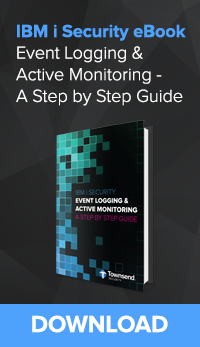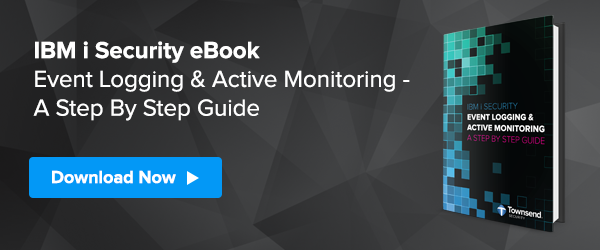Excerpt from the eBook "IBM i Security: Event Logging & Active Monitoring - A Step By Step Guide."
Active monitoring and log collection are at the top of the list of effective security controls. IBM i (AS/400, iSeries) users have to solve some special challenges to implement this critical security control. The IBM i server is a rich source of security information. Unlike many Windows and Linux server deployments the IBM i platform can host a complex mix of back-office applications, web applications, and open source applications and services. For convenience we will address these various log sources in terms of primary sources and secondary sources. Primary sources should be given priority in your implementation processes, as the most critical events are likely to be found in primary event sources.
Primary Sources
 IBM Security Audit Journal QAUDJRN
IBM Security Audit Journal QAUDJRN
When configured properly the IBM i server records a wide variety of security events in the security journal QAUDJRN. Events such as password failures, network authentication failures, failed SSL and TLS network negotiations, application and database authority failures, and many others go straight into the security audit journal QAUDJRN. This would naturally be the first focus of your event monitoring strategy. We discuss the setup and configuration of the QAUDJRN journal below.
System History File QHST
The system history message file QHST (actually a collection of files that start with the name QHST) is also a repository of important security information. All job start, job termination, and abnormal job termination events are recorded in the QHST files. Additionally, important operational messages are written to QHST files and should be collected and monitored.
Exit Points
The IBM i operating system provides a number of “hooks” for network and other services on the IBM i platform. These hooks are referred to as exit points. IBM i customers or vendors can write applications that collect information and register them for the exit points. Once registered an exit point monitoring application can collect information on a wide variety of activities. These include information on inbound and outbound FTP sessions, TCP sockets activity, network authentication, administrative commands through Operations navigator, and many other core operating system services. A good active monitoring strategy should collect information from exit points and pass the information to the centralized log collection server.
Secondary Sources
Web Applications
Most IBM i customers do not deploy the server as a primary web server, but selected web applications and services are often incorporated into a customer’s primary web deployment. The IBM i supports a rich set of web server platforms including IBM Websphere, PHP, Perl, Python, and traditional HTML/CGI services. When web applications are deployed on an IBM i server they are a target for traditional attacks. Web logs should be included in your event collection and monitoring strategy.
Open Source Applications
For some years IBM has been bringing a wide variety of open source applications to the IBM i platform. This includes applications like OpenSSH with Secure Copy (sCP), Secure FTP (sFT) and remote command shell. Many other application frameworks have
been added like Perl, PHP, and Python. All of these applications provide entry points and potential points of compromise for attackers. If you deploy these types of solutions you should enabled and collect their logs.
System and Applications Messages in QSYSMSG AND QSYSOPR
Many customer and vendor applications write important operational and security messages to the system operator message queue QSYSOPR and to the optional system message queue QSYSMSG.

